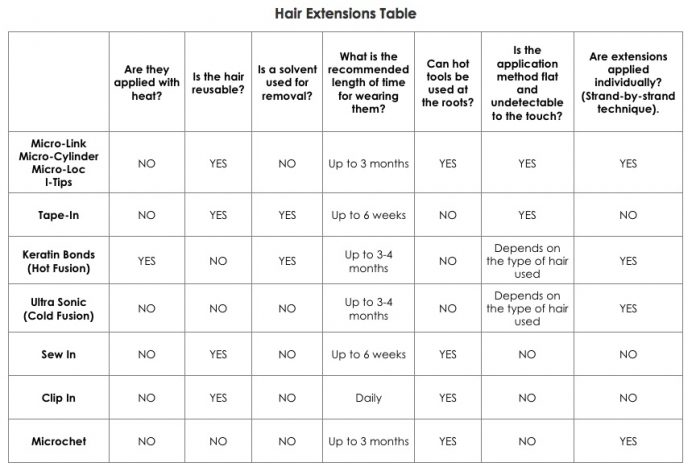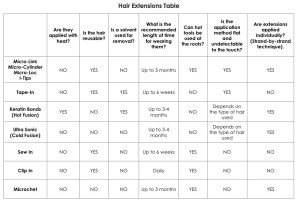
Deb Monti, owner of MilVali Salons located in San Francisco and Mill Valley, California, uncovers the truths, lies and myths related to hair extensions:
As a hair extensions professional for some 18 years, I too often shudder when I see the way some extensions are applied and learn the amount the clients were charged for the shoddy service. When applied correctly, hair extensions can make your hair look thicker, longer and enhance your color without damage. However, when poorly applied, hair extensions can ruin your hair just as bleach, heat, not trimming your split ends, or color not mixed or applied correctly can damage it.
There are many companies in the business of hair extensions that believe their hair, or method, is the best. How does a potential client know where the truth lies and which type is best for their hair?
In my opinion, the extensions and the methods we use at MilVali Salons are the most cost effective, safe, least damaging and most comfortable, using the highest quality hair. Come in for a free consultation to see which hair extensions are right for you. In the meantime, here is a guide to the various types of hair extensions for anyone who is researching extensions and considering wearing them.
Guide to Hair Extensions
Micro Link –– This method is also known as Micro Cylinder, Euroloc, Microloc and I-tip. It is also referred to as Hair-Locs, which is the name of a hair extension brand/company. Sometimes names for brands and methods for extensions are used interchangeably.
A micro-link is a “strand-by-strand” technique that creates a similar result to bonded (hot-fusion) hair extensions, without the use of heat or glue. Strand by strand means that a small individual bundle (about 100 strands) of extension hair is attached to a small section of your own hair, which is different than a weave or weft. A weft is a long strip of hair, usually used for glued-in, clipped-in or sewn-in application.
Micro-Link hair extensions are applied by:
- Dividing your hair into small and precise sections
- Looping a copper link around the section with a special tool
- Inserting a pre-tipped hair extension into the link at the roots
- Clamping the link flat with your hair and the extension inside the link, to secure it
- The link attachment should be 1/8” away from your scalp, and all hairs in the section should be flat to your head so there is no tension or pulling
- The weight distribution between the section of your hair and the extension should be equal, so as not to cause any tension or stress on your own hair
The copper links and extensions that Milvali uses come in various sizes and colors for a customized application. It is important that the hair sections, link size and color are chosen appropriately for each clients’ hair type, texture and color.
We custom order the hair for length, color and texture. Milvali’s extensions come pre-tipped, and are designed with a special plastic seal around the tip, so glue never comes in contact with your hair. These specialized tips make it possible to re-use the extensions up to five times without having to send the hair out for processing; importantly, not all extension brands are designed the same.
There is no heat, glue, sewing or solvents used to attach or remove Micro-links. As mentioned, the hair is reusable up to five times and can be worn for up to 12 weeks. Some brands and salons will lead you to believe that you can wear this type longer, but I advise against wearing any extension method for longer than three months. I recommend that clients with fine or thin hair should only wear them for nine weeks before they are removed and replaced. These links lie flat and are virtually undetectable when hair is worn up or down. Hot tools and any styling products can be used without compromising the attachments.

(Click on photo to enlarge)
Shrinkies — This strand by strand method is similar to Micro-Link extensions, except a plastic tube is used in place of a copper link. It is also referred to as Shrink Links®, which is the name of a hair extension brand/company. Sometimes names for brands and methods are used interchangeably.
Shrink-link hair extensions are applied by:
- Dividing your hair into small and precise sections
- Looping a clear plastic tube around a section using a special tool
- Inserting a pre-tipped hair extension into the tube at the roots
- Heating the connector, which activates glue on the inside of the tube and shrinks it around your hair and the extension to secure it
- The Shrink-link attachment should be 1/8” away from your scalp, and all hairs in the section should be flat to your head so there is no tension or pulling
- The weight distribution between the section of your hair and the extension should be equal, so as not to cause any tension or stress on your own hair
The extension hair is custom ordered for length, color and texture. Milvali’s extensions come pre-tipped and are reusable, but some brands are not. The shrink tubes and extensions come in various sizes and colors for a more customized application. It is important that the hair sections and tube color are chosen appropriately for each clients’ hair type, texture and color.
There is mild heat and minimal glue used to attach and remove Shrink-links. The hair is reusable up to four times (different company’s hair varies) and can be worn for up to 12 weeks. The links do not lie flat but are undetectable when hair is worn up or down. Hot tools and certain styling products cannot be used without compromising the attachments.

(Click on photo to enlarge)
Tape-in — This method is one of the quickest to add length or volume, and the results are seamless. Different hair extension companies offer better tape than others, and hair quality varies. Milvali uses both high quality tape and hair for our extensions. Tape extensions should not slip or feel gummy. The removal should be painless and not leave a sticky residue behind. Extension hair is attached to a flexible, flat strip of material that creates a small weft of hair. The weft has a double-sided tape attached to a smooth surface. Wefts come in different widths and lengths.
Tape-in hair extensions are applied by:
- Sectioning your hair precisely the same width of the pre-taped extension weft
- An extension is taped under and over the section of your hair
- Your hair is sandwiched between the wefts and lies completely flat on your head
- The tape attachment should be 1/8” away from your scalp, and every hair in the section should be flat on your head so there is no tension or pulling
- The weight distribution of the section of your hair and the extension weft should be equal, so as not to cause any tension or stress on your own hair
Tape-in extension hair is always custom ordered for length, color and texture. There is no heat used to attach Tape-in extensions. The hair is usually reusable up to three times and can be worn for up to six weeks. It lies flat and is undetectable when hair is worn down or in a low ponytail. Hot tools can be used, but not at the roots or on the adhesive. Styling products containing alcohol or applied at the root are not recommended as they could weaken the tape attachments.

(Click on photo to enlarge)
Keratin Bonds –– These are also known as Fusion Extensions or Bonded Extensions. Keratin bonded extensions are a hot-fusion, strand-by-strand technique that creates a similar result to Micro-Link extensions, but are fused onto your own hair with heat and a polymer adhesive. Some companies call the adhesive “keratin” because it sounds healthier than glue. Keratin is a protein found in healthy hair and is not an adhesive. Most companies who make this type of extension claim a “keratin bond” is used. Any form of keratin can be combined with a polymer to qualify as a “keratin” bond, though it makes no functional difference nor does it add a benefit to the bond itself.
Bonded hair extensions are applied by:
- Dividing your hair into a small precise section and using a plastic shield to protect your scalp from high heat
- attaching a pre-bonded extension at the root of your hair using a hot tool to melt the adhesive. An adhesive polymer “chip” can also be used if hair is not pre-bonded.
- the hair and extension are rolled or pressed until the seal is cooled and hardened
- The attachment should be 1/8” away from your scalp, and all hairs in the section should be flat to your head so there is no tension or pulling
- The weight distribution between the section of your hair and the extension should be equal, so as not to cause any tension or stress on your own hair
Depending on the brand, the glue can be clear, white, black or dark brown. It is important that the size of the sections and the thickness of the extensions are customized for the clients’ hair type and condition. The extension hair should be custom ordered for length, color and texture. Most brands come pre-tipped, and in different sizes. In some methods loose, untipped hair is also used.
Heat, glue and solvents are used to attach and remove bonded hair extensions. The hair is not usually reusable but can be worn up to 16 weeks. It is undetectable if worn up or down. Hot tools and certain styling products cannot be used near the bonds, as they will weaken the glue and possibly lead to your extensions slipping out. Sulfate–free shampoos and conditioners are recommended, so as not to compromise the bond.

(Click on photo to enlarge)
Ultra Sonic –– This strand-by-strand method is also referred to as Cold Fusion. One of the newest techniques in hair extensions, the bonds in this application method can be flat or round. Flat bonds give a more seamless result while round bonds create more volume.
Ultra-Sonic extensions are applied by:
- Dividing your hair into a small precise section and using a plastic shield as a guide
- Attaching a pre-bonded extension at the root of your hair using an ultra-sonic tool to soften the bond by “vibration”
- The hair and extension are molded into a flat or round bond
- The attachment should be 1/8” away from your scalp, and all hairs in the section should be flat to your head so there is no tension or pulling
- The weight distribution between the section of your hair and the extension should be equal, so as not to cause any tension or stress on your own hair
The attachment is seamless and the bond can be flat. The size of the sections and the thickness of the extensions are customized for the clients’ hair type and condition. The extension hair is custom ordered for length, color and texture. They come pre-tipped, and in different sizes.
Ultrasonic vibration is used to attach and remove these hair extensions. The hair is not usually reusable but can be worn up to 16 weeks. It is undetectable if hair is worn up or down. Hot tools and certain styling products cannot be used near the bonds, as they will weaken the bond and possibly lead to your extensions slipping out. Sulfate–free shampoos and conditioners are recommended, so as not to compromise the bond.

(Click on photo to enlarge)
Microchet® — Also called Japanese Thread, this latest invention uses a tiny thread to attach pre tipped extensions. It is a strand-by-strand technique that creates a similar result to Micro-link, Shrink-Link and bonded (hot-fusion) hair extensions, without the use of heat or glue.
Microchet hair extensions are applied by:
- Dividing your hair into a small precise section
- Using a crochet hook, the pre-threaded extension is looped through your own hair at the root and tied using a tiny thread
- The weight distribution between the section of your hair and the extension should be equal, so as not to cause any tension or stress on your own hair
Since the only bond is a piece of thread, the extensions are light and undetectable. The extension hair should be custom ordered for length, color and texture. The extensions come pre-looped, and up to 40 percent of the extensions can be re-used. There is no heat, glue or solvents used to attach or remove Microchet® extensions and they can be worn for up to 12 weeks. The hair lies flat and is undetectable if worn up or down. Hot tools and any styling products can be used without compromising the attachments.

(Click on photo to enlarge)
Hair extensions at-a-glance:
(click on the picture to enlarge)














